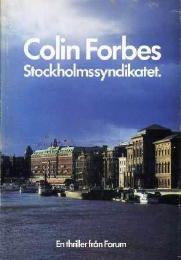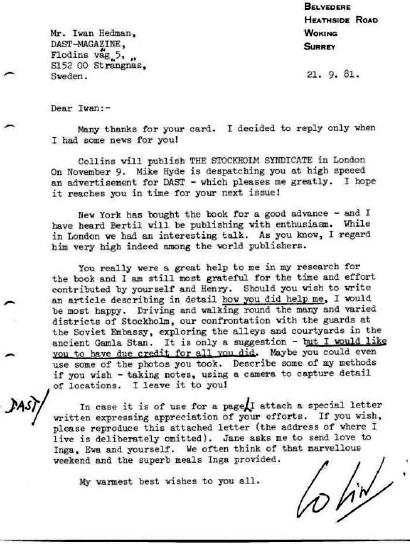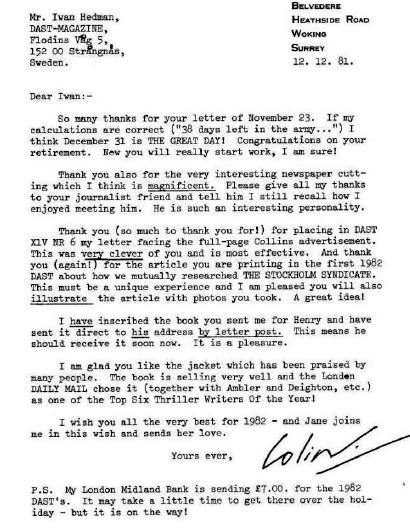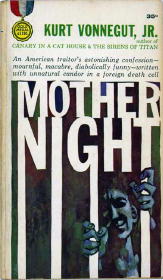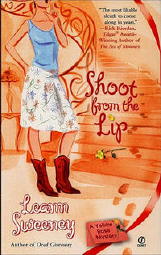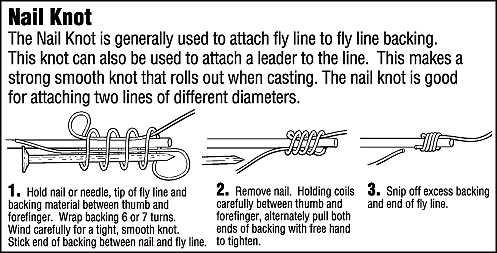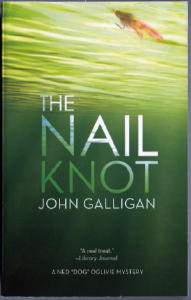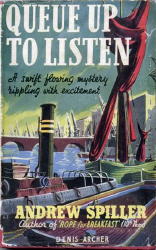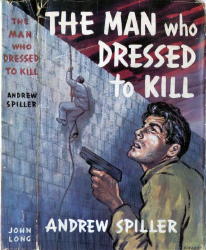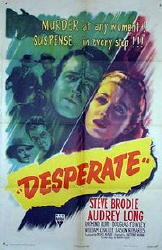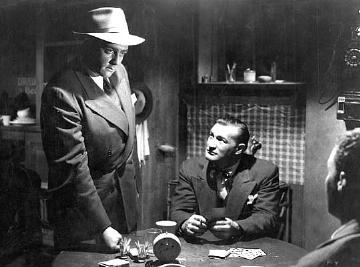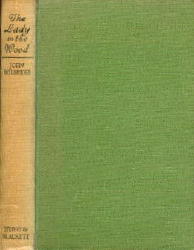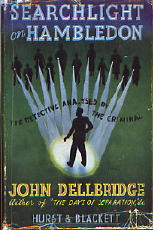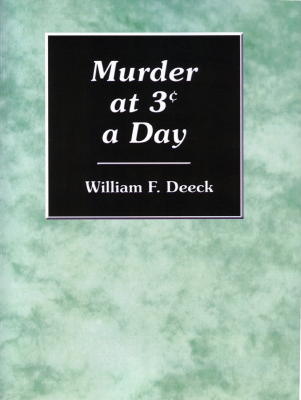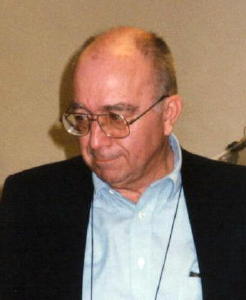April 2007
Monthly Archive
Thu 12 Apr 2007
— Continuing
our conversation posted not too long ago, I said, “What I found extremely interesting is something that has always been at the back of my brain. With all of the interest in the hero pulps, I’ve always wondered why I found them childish if not boring. Your comments answer the question I must have had and never knew enough to ask. They WERE designed for kids. It’s obvious, but I never really realized that.”
Hi Steve,
Another funny thing about my visit that I just remembered: I had an attache case full of Dime Detective and Black Mask pulps to have him autograph but I completely forgot to get his [Morton Wolson’s] signature! I’ve never been much of a collector of signed first editions and this incident proves that I have no interest in autographs. I just want to read the stories.
Concerning the hero pulps, in 1969 I saw my first large group of hero pulps at Jack Irwin’s house. I had visited him to buy Black Mask, Dime Detective, Detective Fiction Weekly and Weird Tales. I read and looked through a few pages of G-8, Doc Savage, The Shadow, etc. I still remember my puzzled reaction and question to Jack along the lines of: “But why are you reading and collecting children’s magazines?” I found the stories clearly unreadable and silly.
He defended them along the lines of nostalgia which is OK, but to this day, I do not understand how adults can read these stories. That’s why I often engaged Harry Noble and my wife’s father in long conversations about the pulps that they and their friends read back in the 1930’s and 1940’s. I was curious as to pulps the adult working man really read. Because to read some of these recent articles, you would think that a lot of men read these poorly written, silly hero pulps. I guess some did read them, but according to my verbal research, the main readership of the hero pulps was definitely teenage boys.
The teenage girls made the love pulps the biggest seller of all. If you really want to turn your brain into mush, try reading a love pulp. Talk about formula fiction! I read a few issues, and I still have not recovered from the experience. Every story had the same plot with a happy ending of course because that’s what the girls wanted in their romance fiction back in the 20’s, 30’s and 40’s. Boy meets girl, girl and boy have some troubles, things look bad for the romance, boy and girl resolve their problems, and live happily ever after.
I only know of one collector that seriously collects the love pulps and I have to withhold his name to protect the innocent plus it would ruin his life and reputation if the news ever got out.
Thu 12 Apr 2007
AN OLD FRIEND HAS LEFT US
By Iwan Morelius
As long back as I started to collect books I had as a habit to write to those authors I liked very much. After a while they were many of them and among the earlier ones was Colin Forbes , well known thriller writer from England. The first thriller by him was in fact Avalanche Express, which turned out to be a smashing movie some years later.
Colin was kind enough to answer my letters and we were pen friends for many years before he wrote me a letter telling me he was going to visit Sweden ( Stockholm) in order to make research for his next thriller. Wow, how exciting! Hopefully I should meet him in person. Of course! Colin asked me if I wanted to help him with his research. To that it was only one answer – YES!
Colin and his wife, Jane, should come for one week in June 1978 and we met the first day he was in Stockholm at his Swedish Publisher’s office. The Publisher invited us for a lunch and there were Colin, Jane and the publisher Bertil Käll and me, a captain in the Swedish Army. We had a nice – and very good tasting – typical Swedish lunch together and during it Colin informed me what he wanted for the research.
The next morning I met Colin outside his hotel, Grand Hotel, in Stockholm and we started to have a typical Swedish breakfast. Then we started by car to my hometown Strängnäs, situated 70 km west of Stockholm. During the drive Colin gave me more details about the book and what help he wanted from me. First of all he wanted two things:
1. First an exciting place where his hero should be involved in a fight and nearly killed
2. The second thing he wanted to see was a typical Swedish forest with giant trees. He had heard we had trees being as high as 30 meters.
I suggested a place, which I had visited many times and found very, very exciting. It was situated in the middle of a forest and had once been used for mining. Still there were many deep (I mean really deep) holes and the fence was gone many years ago. Some people used the holes to put their old cars in). Colin inspected the place carefully and he was very satisfied with the place I had chosen.
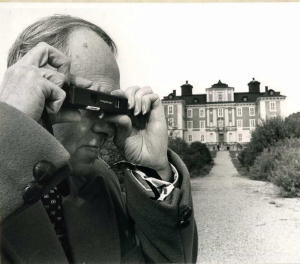
Outside the Mälsåker’s Castle.
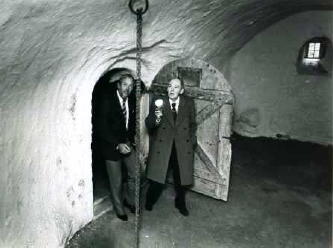
Colin and I deep in the cellar vaults.
On our way to my home we took a little extra driving and found a place with the kind of trees he wanted (so far I didn’t know why he wanted to find them). Colin was very satisfied with his first day on his research. We drove to my home and had some tea and Colin inspected my library and he was especially satisfied with my collection of signed books by so many famous authors. At that time I had around 15,000 mystery books (Mystery/Thrillers and Science Fiction plus non-fiction in the genre).
We offered Colin and Jane to stay over night but they refused. Colin wanted to work on his book and wanted to be in his hotel then, which I respected of course. So I drove them back to Stockholm and their hotel.
Before I left Colin asked me if I knew someone who knew Stockholm on his five fingers, as we say in Sweden. Of course I did and I phoned my old friend Henry Augustsson, a goldsmith in Stockholm, who was more than happy to be of help. He was also a keen book collector.
Next day we were outside the hotel very early and our first goal was the Russian Embassy, situated in the middle of Stockholm. I parked my car (a Volvo Station wagon) outside the Embassy and took out a big (large?) map and put it on the car. It took only two minutes and a special guard, not from the Embassy, but from a Swedish guard company who have guards outside every embassy in Stockholm. The guard told us to leave at once but we told him we would not.
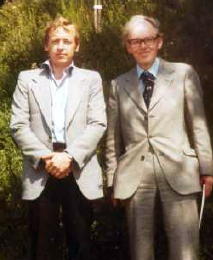
Henry and Colin outside the embassy.
This is a common place where everyone who wanted it could stay or park his car. So we continued to study our map over Stockholm and make some notes and drawings when the guard disappeared. Henry, who knew what he was doing, told us he phoned the Swedish police. Before the police arrived we took our photos and waved goodbye to the guard – the “Dummy”, we called him.
Our next stop was Djurgården (Animal garden, roughly translated), one of the most beautiful places in Stockholm with water, open places, parks and paths for walking etc. Colin wanted to find a luxury yacht for his book. And that was very easy to find here where the rich people in Stockholm had their yachts and big motorboats.
Next stop was Kaknäs tower, a tower from where you could view the whole of Stockholm. I think it is around 60 meters height and on top there is a restaurant. Colin invited Henry and me for lunch. From the top we could see the Värta Harbour, from where the ferries to Finland go and were also most of the oils are placed. Colin asked Henry if it was possible for a big Russian fright boat to anchor there. The answer to that was YES and Colin was satisfied again.
Next goal was Stockholm’s The Old Town (Gamla Stan) where he could look at all those very old houses, walk in the narrow streets and also have a look inside the yards of the houses. We talked to some people who lived there and they showed Colin the use of the key locks (the coded ones). He liked that and told us it should be in the book.
Colin was very satisfied with his day and asked us if we would like to join him and Jane for dinner at Grand Hotel’s French Veranda (a glassed veranda), from where we could have a nice look over The Strömen (the water between Grand and the Royal Castle). Another YES, of course!
This was Colin’s first visit to Stockholm, but not his last and later on I was to be invited to their home in England (Woking, Surrey).
BIBLIOGRAPHY: Expanded from Crime Fiction IV, by Allen J. Hubin:
FORBES, COLIN; pseudonym of Raymond H. Sawkins, (1923-2006); other pseudonyms Jay Bernard & Richard Raine (books)
* -The Heights of Zervos (n.) Collins 1970 [Greece; 1941]
* The Palermo Ambush (n.) Collins 1972
* Target Five (n.) Collins 1973 [Arctic]
* Year of the Golden Ape (n.) Collins 1974 [San Francisco, CA; 1977]
* The Stone Leopard (n.) Collins 1975 [France]
* Avalanche Express (n.) Collins 1977 [Train]
* The Stockholm Syndicate (n.) Collins 1981
* Double Jeopardy (n.) Collins 1982 [Tweed; Vienna]
* The Leader and the Damned (n.) Collins 1983 [Germany; WWII]
* Terminal (n.) Collins 1984 [Tweed; Switzerland]
* Cover Story (n.) Collins 1985 [Tweed; Scandinavia]
* The Janus Man (n.) Collins 1987 [Tweed]
* Deadlock (n.) Collins 1988 [Tweed]
* The Greek Key (n.) Collins 1989 [Tweed; Greece]
* Shockwave (n.) Pan 1990 [Tweed]
* Whirlpool (n.) Pan 1991 [Tweed]
* Cross of Fire (n.) Pan 1992 [Tweed]
* By Stealth (n.) Pan 1993 [Tweed]
* The Power (n.) Pan 1994 [Tweed]
* Fury (n.) Macmillan 1995 [Tweed]
* The Precipice (n.) Macmillan 1996 [Tweed]
* The Cauldron (n.) Macmillan 1997 [Tweed]
* The Sisterhood (n.) Macmillan 1998 [Tweed]
* Sinister Tide (n.) Macmillan 1999 [Tweed]
* This United State (n.) Macmillan 1999 [Tweed]
* Rhinoceros (n.) Simon & Schuster, 2001 [Tweed]
* The Vorpal Blade (n.) Simon & Schuster, 2002 [Tweed]
* The Cell (n.) Simon & Schuster, 2002 [Tweed]
* No Mercy (n.) Simon & Schuster, 2003 [Tweed]
* Blood Storm (n.) Simon & Schuster, 2004 [Tweed]
* The Main Chance (n.) Simon & Schuster, 2005 [Tweed]
* The Savage Gorge (n.) Simon & Schuster, 2006 [Tweed] Published posthumously.
Note: Tweed is Deputy Director of the SIS, the British Secret Intelligence Service.
SAWKINS, RAYMOND H(arold); see pseudonyms Jay Bernard, Colin Forbes & Richard Raine.
* Snow on High Ground (n.) Heinemann 1966 [Supt. John Snow; England]
* Snow in Paradise (n.) Heinemann 1967 [Supt. John Snow; Italy]
* Snow Along the Border (n.) Heinemann 1968 [Supt. John Snow; England]
BERNARD, JAY; pseudonym of Raymond H. Sawkins; other pseudonyms Colin Forbes & Richard Raine
* The Burning Fuse (n.) Harcourt, US, 1970 [Germany]
RAINE, RICHARD; pseudonym of Raymond H. Sawkins; other pseudonyms Jay Bernard & Colin Forbes
* A Wreath for America (n.) Heinemann 1967 [David Martini; England]
* Night of the Hawk (n.) Heinemann 1968 [David Martini; England]
* Bombshell (n.) Dent 1970 [David Martini; Switzerland]
Thu 12 Apr 2007
Kurt Vonnegut died yesterday at the age of 84. In many ways, he was the Mark Twain of our time, and there are many other websites which will discuss his life, his writings, and his awards and accolades. What follows in this blog entry will be less an obituary, however, than a personal note or two about the author, no more or no less.
Back in the mid-1960s, I responded to a poll in a science fiction fanzine which wished to know my Top Ten SF novels. I remember only my top two choices, Number One on my list being The Man in the High Castle by Philip K. Dick, which won the 1963 Hugo award for Best Novel of the Year.
Number Two was Cat’s Cradle, by Kurt Vonnegut, Jr. Thinking about the book as soon as I heard the news last evening about Mr. Vonnegut’s death, I realized that besides being about the mysterious substance “ice-nine,” a dangerous alternative form of water, I no longer remember very much else about the book. I probably do not remember the details of very many other books I read 40 to 45 years ago, but no matter; this realization is jarring, and it means that I shall have to do something about that.
From the Wikipedia page for Mr. Vonnegut, I have excerpted the following passage:
In Chapter 18 of his book
Palm Sunday “The Sexual Revolution,” Vonnegut grades his own works. He states that the grades “do not place me in literary history” and that he is comparing “myself with myself.” The grades are as follows:
* Player Piano: B
* The Sirens of Titan: A
* Mother Night: A
* Cat’s Cradle: A-plus
* God Bless You, Mr. Rosewater: A
* Slaughterhouse-Five: A-plus
* Welcome to the Monkey House: B-minus
* Happy Birthday, Wanda June: D
* Breakfast of Champions: C
* Slapstick: D
* Jailbird: A
* Palm Sunday: C
That the author gave himself an “A plus” for Cat’s Cradle reassures me somewhat, that as a critic at the young age I was at the time, my judgment on a book’s worth was not entirely lacking.
Very soon after writing Cat’s Cradle, Mr. Vonnegut declared himself not a science fiction writer, as I recall, nor (I suspect) did he ever consider himself to be a crime fiction writer. But one of his books, Mother Night (Gold Medal s1191, paperback original, 1962) is included in Crime Fiction IV, by Allen J. Hubin.
I have to confess that I’ve never read the book, and my records reveal that I do not even own a copy. Nor do I remember the movie made from it, a 1996 film starring Nick Nolte, Sheryl Lee and Alan Arkin. It seems to have come and gone having made impression on me whatsoever. Whether this was due to a limited release to a diminishing number of “art” theaters in the country, or my own lack of attention, I do not know, but once again, here is a situation that I see needs remedying.
I’ve tried to understand the detailed synopsis of Mother Night which I found on Wikipedia, but perhaps Mr. Vonnegut’s are too complex to be summarized in a short detailed synopsis. Either you write a book about one of his books, or you try not at all. Or maybe you resort to only one line – this one, perhaps, from the IMDB page for the movie:
“An American spy behind the lines during WWII serves as a Nazi propagandist, a role he cannot escape in his future life as he can never reveal his real role in the war.”
One thing I’m sure of, or maybe it’s two. Mother Night was certainly not a typical Gold Medal book, nor was Kurt Vonnegut, Jr., a typical American author.
Wed 11 Apr 2007
Posted by Steve under
Authors ,
ReviewsNo Comments
LEANN SWEENEY – Shoot from the Lip
Signet, paperback original, January 2007.
There are a few private detectives in the world of crime fiction that Kevin Burton Smith doesn’t (yet) know about, he of the Thrilling Detective website, which attempts to list ALL of them, and in all honesty, he pretty well succeeds. Case in point, though: He’s missing Houston-based Abby Rose, who’s in this book, her fourth case overall, the previous three being:
Pick Your Poison. Signet, pbo, May 2004. Abby inherits her late father’s home and computer business along with her twin sister, Kate. When she investigates the murder of their gardener, she learns some truths about their true birth parents.
A Wedding to Die For. Signet, pbo, January 2005. Independently wealthy, Abby has started her own business as a private investigator finding birth parents for adoptees. Her client is a bride-to-be who hires Abby to find her biological mother so she can be at her wedding, but a murder occurs at the reception instead.
Dead Giveaway. Signet, pbo, November 2005. After Abby is hired by a 19 year old basketball star looking for his birth family, the woman who found him on her doorstep as an infant is murdered.
In spite of all of the murders and the fact that Abby is a fully licensed PI, these are all “cozy” type mysteries, and so is the book in hand, Shoot from the Lip. Yellow Rose Investigations is the name on her business card. Her twin sister Kate, a psychiatrist, does the psychological assessments on any prospective clients, and with money in the bank, she can easily afford to turn down clients whose cases she doesn’t wish to take.
Her client this time around is young Emmy Lopez, who’s been responsible for her three younger siblings ever since their mother died. An upcoming appearance on a TV reality show brings out the possibility that there was a fourth child Emmy never knew about and who may have been put up for adoption, either legally or (more likely) illegally.
The story’s told in raw-boned but light-hearted Texas style, with lots of details of the two sisters’ various romances with their steady (and not so steady) boy friends, along with Abby’s continual references to her daddy, now gone but far from forgotten.
Murders do occur in this book, which I have just realized that I have forgotten to mention, but unfortunately the detection involved is slim to none. Not only are Abby and her circle of family and friends relatively slow on the uptake when dangerous things begin to happen, but the killer makes the fatal flaw of simply hanging around too long. He or she is caught only by doing one evil deed after another, until eventually going too far, when at last the truth is revealed.
Don’t get me completely wrong. For fans of low-keyed murder investigations, enhanced and enlivened by a crew of friendly folk who seem to come back book after book, they could do far worse than stay with Abby Rose, wherever her adventures may take her.
— February 2007
Tue 10 Apr 2007
JOHN GALLIGAN – The Nail Knot
Worldwide; paperback reprint, October 2006. Trade paperback: Bleak House, May 2005.
A “nail knot” is one of those clever devices that are used most often by fly fishermen, and as such it is something I knew nothing about before reading this book. (The last time I went fishing was with my grandfather when I was ten or so, when all we did was to drop our lines into water off a long pier jutting out into Lake Michigan. No casting abilities of any kind required. Nor did we catch anything, but why do I still remember the day, now well over fifty years ago?)
The primary protagonist of The Nail Knot, a laid back sort of fellow who calls himself the Dog, is a fly fisherman, however, and I’ll get back to him in a minute.
In the meantime, here is a short list of other mystery novels or series which I’ve just come up with in which fly fishing is a substantial component, in no particular order.
Firehole River Murder, by Raymond Kieft, first book in the “Yellowstone Fly-Fishing Mystery Series.” Series character: name not known.
Blood Atonement, by Jim Tenuto. Series character [SC]: fly-fishing guide Dahlgren Wallace.
Bitch Creek, by William Tapply. SC: Stoney Calhoun, amnesiac worker in a bait and tackle shop in rural Maine.
Pale Morning Done, by Jeff Hull. SC: Montana fly-fishing guide Marshall Tate.
Dead Boogie: A Loon Lake Fishing Mystery, by Victoria Houston. SC: Chief Ferris, Doc Osborne and Ray Pradt. [There are several in this series.]
There are probably others that I am not thinking of now. Please add others, if you can. This is the first of at least three books in John Galligan’s “Dog” series, but some research shows that he wais the author of one earlier mystery novel, Red Sky, Red Dragonfly, also published by Bleak House (in 2001), in which a hockey player from Wisconsin travels to Japan to teach English for a year and ends up being implicated in his predecessor’s disappearance.
Subsequent and/or reportedly forthcoming follow-ups in John Galligan’s fly fishing series are:
The Blood Knot. Bleak House, hardcover, October 2005. [UPDATE: Bleak House, trade paperback, March 2007.]
The Clinch Knot. Bleak House. Spring, 2007. [UPDATE: Unpublished as of April 2007.]
The Surgeon’s Knot.
The Wind Knot.
The Hex.
This is a long-range projection, and I suspect that some of these titles may turn out to be totally hypothetical. But assuming that you’re still with me, let’s take a look at the book in hand. As mentioned above, “the Dog” is how the leading character refers to himself — he tells the story, and on a strictly personal basis, it’s quite a story that has to tell.
The Dog’s real name is Ned Oglivie, and he is what you might call a dropout from the human race, wandering across the country and checking out fishing spots as he goes. A nomadic fly fisherman without parallel, you might say. Until he reaches Black Earth, Wisconsin, that is, where it is that he finds a body along the edge of the creek that leading into (or out of) local Lake Bud. (You can see that even though it may be an important plot point, it didn’t make much of an impression on me.)
He also finds The Woman, but not until she removes from the crime scene all of the evidence that (Dog later learns) points to her semi-senile father. But let the Dog describe the lady, from page 13:
… and it was impossible for me to take my eyes off her.
You expect me, I suppose, to tell you that she was a gorgeous creature, or lay out for you some other such cunning nonsense. But it wasn’t like that. The last thing the Dog wanted in those days was attraction to a woman. Plus that was far from the mood, and this woman was anything but gorgeous. She was more like confusing. She had already shown me the clod-hopping ability of a teen-aged boy. She was dressed like that too — dirty jeans and work boots, a t-short that had once been white, a dirty-green John Deere cap with a pair of cheap sunglasses up on the brim. Her thighs and arms and shoulders were thick, and her posture atop the stream mud was on the dark side of dainty. But there was a frazzled spark of red-blond ponytail sticking out the back of the cap. There were breasts strapped down by a sports bra beneath the t-shirt. There were tears in her eyes. Earth to Dog: woman.
You can tell at once that the Dog is hooked. Her name is Melvina Racheletta O’Malley, or Junior for short, and the Dog discovers to his dismay that he cannot walk away when she asks him to help her in what she insists is a frame-up of her father, Mel.
The dead man has only lately been a local, which first of all is not a good thing in rural Wisconsin, and secondly he had been an activist in trying to revive and save the fish in Lake Bud, which is also definitely not a good thing — activism, that is.
The solution to the mystery depends greatly on who was able to tie a nail knot, and at what time. It wouldn’t have been a terribly difficult case to solve, if one had a protagonist who was a little more, shall we say, pro-active on the case — you soon get the feeling that if the Dog were any more low key than he is, he wouldn’t be able to get up in the morning — but then again meeting all of the local folk, some more local and inbred than others, and some not, would have been not nearly so much fun as this.
UPDATE. Quite coincidentally there has been a discussion of fly-fishing mysteries on DorothyL this past week (early November), in relation to a slightly different topic of “male cozies.” Here are a couple more mystery series that have been pointed out as belonging to the category, still small but obviously growing:
Fly Fishing Can Be Fatal, by David Leitz. SC: Max Addams, owner of a northern Vermont fishing lodge. [There are several other books in this series.]
Catch and Keep, by Ronald Weber. SC: Northern Michigan conservation officer Mercy Virdon and her boyfriend, newspaperman Donald Fitzgerald. [There is at least one other book in this series.]
Death on a Cold, Wild River, by Bartholomew Gill. SC: Dublin police Chief Superintendent Peter McGarr, who is the detective in several other books by Gill. In this one, though, it’s the victim who is the fly fisherman, along with at least one of the suspects.
Mon 9 Apr 2007
Posted by Steve under
Authors ,
Covers[8] Comments
A short while ago I posted a blog entry about a group of authors whose deaths had recently been noted. One of those authors was Andrew Spiller, about whom I knew nothing at the time, except for the list of mystery fiction he wrote, which you’ll find by following the link.
To learn more, I first emailed John Herrington:
John
I tried a Google search for Spiller and/or Inspector Mallard, and found … nothing. Another author like Brian Flynn, perhaps, popular only because he wrote a lot of books and for very little other reason?
Hi Steve,
I wouldn’t disagree. I have managed to borrow a couple of his books though inter library loans and they are nothing special.
Have discovered that he was working for the British-American Tobacco Company in 1950. He is like a lot of writers of the 1940s and 1950s, who stopped writing by the end of the 1950s. A lot of the smaller publishing companies were disappearing (or being bought up) and perhaps he realised that there was no longer a market for his books. This happened to the likes of ‘Ernest Dudley’ who stopped writing crime around the same time because there was no money in it.
Then arrived a welcome email from Jamie Sturgeon:
Steve,
Did John mention that Andrew Spiller worked for British American Tobacco and his wife’s name was Marie? Please see attached scans, including two more covers in DJ.

—
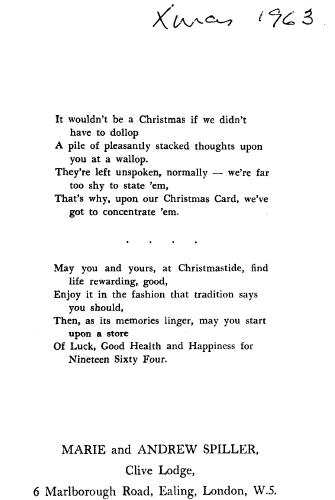
Then from Victor Berch, who has managed to delve deeply into Andrew Spiller’s traveling days:
Steve
Remember my mentioning that database which contained information on aliens and citizens entering the US? Well, I decided to poke in Andrew Spiller’s name and to my surprise two hits came up. I wasn’t too sure I had the right Andrew Spiller, but when I spotted his birthplace of Bridport, I knew I had the right person. So, here are some of the details from those records that I gathered from the ships’ manifests:
On his first trip to the US, Andrew Spiller came aboard the SS Olympic which left Southampton, Eng on Feb. 25, 1925 and arrived in New York March 4, 1925. From this manifest, it stated that he was in transit to visit his cousin, C. James, in New Zealand. He was listed as an advertising agent for the British American Tobacco Co, Ltd (which, by the way is still in operation). His age at the time was given as 35 years old. He was 5’9 1/2″ with brown hair and grey eyes.
On his second trip, he came aboard the SS Aquitania, which left Southampton, Eng on April 28, 1928 and arrived in New York May 4, 1928. Spiller was still listed as advertising manager for the British American Tobacco Co., Ltd and was going to stay in the US for 60 days.
On this record he was required to give the name and address of his nearest kin, which was Mrs. A. Spiller, 26 Heathfield Rd., Acton, W. 3 , London. These records seem to predate his writing period.
And so there you are. Bits and pieces of a life of a mystery writer who’s become obscure and all but forgotten now, but who was very prolific in his time.
For a gallery of even more covers, provided by Jamie Sturgeon, I’ve set up a separate website here.
Mon 9 Apr 2007
DESPERATE. RKO Radio Pictures, 1947. Steve Brodie, Audrey Long, Raymond Burr, Douglas Fowley, Jason Robards (Sr.). Directed by Anthony Mann.
An early film noir, back before directors knew that that’s what they were filming, back when a low budget on a crime film was the impetus for creative lighting and innovative camera techniques, and not because they realized that they were creating a movie genre.
I reviewed Anthony Mann’s The Great Flamarion (Republic, 1945) earlier this year, a movie considered by some to be in the noir genre, so Desperate is far from being the first that he directed in the category, but to me, both seem flawed. Neither seems to me to epitomize in their entireties what a noir film truly is (or was).
But there are some moments in Desperate that, once seen, will always be remembered. When trucker Steve Randall (Steve Brodie) is being thoroughly beaten off camera in the hideout of gangster Walt Radak (Raymond Burr), someone bumps the overhead light fixture with a single light bulb in it, starting it to swing back and forth in the otherwise darkened room. The alternating light and shadowy darkness combines with the sounds of punches and groans off to the side in an epiphany of mind-cringing delight.
Toward the end of the movie, as Radak has caught up with Randall again, as Radak’s brother is about to die in the electric chair, for which Radak blames Randall, the two men sit opposite each other across the kitchen table in a cheap apartment flat, Radak with a gun in his hand, Randall about to die at exactly the same moment as Radak’s brother — their eyes, their sweat — it is as if that moment will stay fixed in time forever, but it does not, as the clock ticks slowly onward.
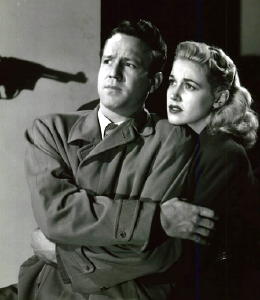
One could wish, then, and fervently so, that the overall story would hold together more cohesively than it does. Why Randall’s wish to escape Radak is clear. He’s an innocent joe caught up in a foiled warehouse robbery, but when Radak threatens his wife of four months (Audrey Long), he becomes irrational with his thoughts of saving her — but his actions, setting them both off on the run without telling the police, just don’t make sense. Randall doesn’t ever appear quite irrational enough, nor is he supposed to be. His wife Anne simply does as she’s told — questioning but always obeying — and yet she wouldn’t if he were.
This was Raymond Burr’s second or third credited appearance, and as a moody almost insane criminal thug, which is what he often played in B-movies like these in the 1940s, his eyes seem to glower whenever he’s filled with anger or hatred. In this movie this is 95% of the time.
One other problem this movie faces, however, is that Mr. and Mrs. Randall, no matter how dire their situation, when they’re together, it’s never quite dire enough. There is no question that they will survive, and in a noir film, that’s always a fatal flaw. But so that I can’t be accused of giving away an ending: I just lied, and they don’t.
Here’s one connection with crime fiction in printed form that I didn’t know before now. Audrey Long’s film career, which began in 1942, ended in 1952 when she married Leslie Charteris, creator of the Saint. Their marriage lasted until 1993, when he died.
Sun 8 Apr 2007
JOHN DELLBRIDGE – The Lady in the Wood
Hurst & Blackett Ltd., hardcover; no date stated [1950]. No US publication.
As readers of this blog will know full well, it has recently been discovered that “John Dellbridge” was the pen name of Frederick Joseph De Verteuil (1887-1963). A native of Trinidad, he became a barrister and practiced law in India and England before becoming a novelist.
I’ll forego the usual bibliography, as the previous entry already includes one, as well as a small amount of other information that has been learned about the author. There are six mysteries to his credit in all, however, the last three having as their lead character one Rupert Hambledon, about whom more in a minute. The Lady in the Wood is the last of the three, which were published in a short span between 1947 and 1950. Dellbridge’s earlier crime-writing career spanned a much earlier 1927 to 1929.
The story is told in quasi-documentary style, in the beginning as if in the form of local Inspector Kemsing’s report to some superior officer, starting with Chapter One, page 7:
At 6:30 p.m. yesterday, Friday, and August, Mrs. Martineau of Sharpes Cottage, Checksworth, reported by telephone that she and her husband had found the naked body of Lady Charlotte Barnet in a larch plantation in Checksam Park. There seemed to be a bullet wound in the head. Her husband was standing by the body. She described the exact spot. I telephoned the police surgeon and the St. John Ambulance and at once proceeded to the scene by car with Sergeant Streeter and Constables Neve, Avis and Ayling, with a camera. Mrs. Martineau was waiting for us at the junction of a bridle path and the Diddlehurst-Midworth road: Sharpes Cottage is about fifty yards East of the junction of the path and road and invisible from the path as the road bends there.
The dead woman had been a heroine in World War II, having parachuted into France and done great deeds undercover with the Resistance. Some Vichy French and some members of the Gestapo are immediately suspected. On the other hand, this is England, and the world is in the process of becoming civilized again. Lady Barnet had come down from London to be one of the guests at nearby Schlatts Hall, the home of Mr. and Mrs. Arthur Bonteve.
So a manor house mystery is what this is, no more and no less, replete with constant and subsequent misbehavior and strange actions on the part of the many participants, many clues, another death – that of a maid who perhaps knew too much and who turned to blackmail as a result? – and endless timetabling, more than I can remember in any mystery I’ve read in many years.
Sir Rupert Hambledon is called in early on by one of the suspects. That he has a title means that he travels in the same circles as the class of people who live in or are guests at manor homes. He is not from Scotland Yard, however, but a very expensive inquiry agent. (One hesitates in referring to him as a mere private detective.) Being the “best known detective in England” and “the smartest” (page 111), in no time at all he is in charge of the case, Inspector Kemsing more than willing to defer to him.
One of Sir Rupert’s other traits is that “he commits irregularities that no official policeman would dare to try” and “these irregularities get results.” (Also page 111.) By the way, the inspector does not narrate the entire book. He alternates telling the story of the investigation with Mr. Perceval Hadlow-Down, a solicitor of one of the guests, who often plays Watson to Sir Rupert. Says Hadlow-Down early in his own narrative, when it is his turn;
I am a thriller ‘fan’. Many of them are very good, though they have lost some of the savour since Lord Peter Wimsey went out of business and Dr. Fortune was replaced by a colleague of mine called Clunk who should have been struck off years ago.
Sir Rupert may outdo either of those two gentlemen by stating on page 70:
“I’ve known who the murderer was since this morning,” he asserted with a stort of Olympian impatience.
Of course there is not a shred of legal evidence at this point, and if the murderer were to be charged, the inspector would be “laughed out of court.”
Does Sir Rupert indeed know? In the end, after the killer is indeed caught and charged, there are indications that he did, but to my mind, the strongest point in his final summary of the case was based on an flimsy (and even erroneous) insight into human nature. He was exaggerating, were you to ask me. It was a good guess, perhaps more, but that it took the remaining two-thirds of the book to name the killer for keeps strongly suggests that a good guess is all that it was.
The purpose of the alternating narration – not too common in detective novels? – serves the author in this case well. That is to say, it keeps the reader off-balance, preventing her or him of being aware of what each narrator knew and when while the story was being told by the other.
In short, however, if you are the kind of mystery reader who likes lots of clues, time tables, and exhaustive interrogations of the parties involved, you will find a lot to like, if not love, in this book. If not, then most definitely not.
— February 2007
Sun 8 Apr 2007
I have mentioned Bill Deeck’s book, Murder at 3 Cents a Day, before, along with various updates as to the online version, as additional covers scans have gradually been included.
What I now have is the great pleasure in announcing is that I have the book itself in my hands, and it is well worth the wait, almost. One can only regret that Bill Deeck is no longer with us to see it, but it is certain that he would be immensely pleased with it.
FROM THE BACK COVER —
Murder at 3¢ a Day is the first and only reference volume devoted entirely to the lending-library publishers that flourished from the mid 1930s into the 1960s. More than ten years in compilation, it contains full listings of mystery and detective fiction published under such imprints as Phoenix Press, Hillman-Curl, Mystery House, Gateway, Arcadia House, Dodge, and Caslon.
Included are dust jacket blurbs, settings, and leading characters for each title, as well as descriptions of jacket illustrations and names of the artists who designed them. Also included: an article about the lending-library trade written in 1939 by Charles S. Strong, who specialized in this type of novel; a tongue-in-cheek article on Phoenix Press mysteries by Bill Pronzini; brief biographies of many lending library writers; and selected period newspaper reviews of various titles.
Readers and aficionados alike will find a wealth of fascinating and often amusing information about this little known variety of crime fiction. Murder at 3¢ a Day is a must for any reference shelf.
William F. Deeck (1927-2004) was a well-known mystery fan and collector who had a special affinity for lending-library fiction. In addition to the present volume, he was the author of numerous articles and reviews for The Armchair Detective, Mystery Readers Journal, and other publications.
INTRODUCTION, by Bill Pronzini:
What you hold in your hands is a labor of love.
There have been scores of biographical and bibliographical reference works devoted to quality mystery fiction, but only a couple – Gun in Cheek (1982) and Son of Gun in Cheek (1987), both written by yours truly – that pay tribute to the genre’s lesser lights. And until the present volume, there has been no detailed source of information on the hundreds of mysteries published by, and the writers who wrote primarily or exclusively for, the lending-library markets that flourished in the 30s, 40s, 50s, and lasted well into the 60s.
Murder at 3¢ a Day was conceived by Ellen Nehr, as a similar volume to her Doubleday Crime Club Compendium (1992), with Bill Deeck acting as assistant. A relatively small amount of material had been gathered when Ellen died late in 1995; it was Bill, with help from various other collectors and aficionados, who did most of the work of researching, compiling, and annotating the entries and who therefore earned the solo byline. After Bill’s death in 2004, I inherited the project – the adding of new material when found and the search for a publisher. Others deserving of heartfelt thanks for their efforts include Allen J. Hubin, Steve Lewis, Richard Moore, and Mark Terry.
Any reader and collector of crime fiction, whether or not a fan of the odd, obscure, and delightfully absurd (Bill’s original title for the volume was Mostly Awful), will find much to entertain and enlighten them here. Some who were previously inclined to scoff at “alternative” mysteries might well join the growing number of us who consider them irresistible.
For you, Bill, and Ellen too, with gratitude. I wish you were both here to see it published.
The main page of the online companion to Murder at 3 Cents a Day is www.lendinglibmystery.com, where you can also find information about the publisher, The Battered Silicon Dispatch Box, owned and operated by George A. Vanderburgh. It’s too soon for the latter’s website to include the book, but I believe the retail price to be $30.
The cover scans for the Phoenix Press mysteries are now complete through 1947.
Sat 7 Apr 2007
Posted by Steve under
Authors[4] Comments
Hallo Steve!
Yes, Donald Hamilton died in Visby (Gothland) Sweden on 20th of November last year. Unfortunately I didn’t know about his death until an English friend of mine, Jeremy Dund living in Stockholm, e-mailed me about it.
I knew him well through my correspondence with him, and also because my wife and I visited him and his wife in their home in Santa Fe, many years ago. We were invited to stay a full week there, and we had a lot of nice hours together.
He also visited me in my home when I lived alone in Sweden (1983). He and his wife Kathleen had dinner with me in my home at that time.
He was a very nice and generous man, and he knew that his books were very popular all over the world.
When I visited him last year in August in Visby – in fact my hometown when I was 15 years old till I was 23 and moved to Uppsala (where Donald was born) – he was in a home for the elderly, but he was in very good condition although his memory was not 100%. But he remembered me and the visit in Santa Fe, and we talked for a full hour about that and his books etc.
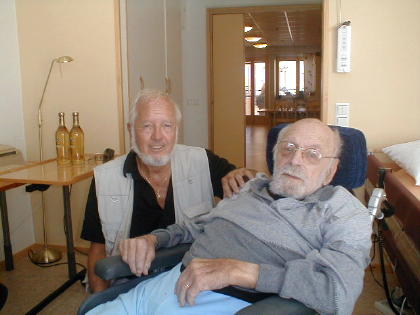
Iwan and Donald Hamilton
His son Gordon then came and I talked to him and his wife. They had decided to take care of Donald for the rest of his life. The home he was staying at was excellent, and the service was the absolutely best you can get.
I’ll be driving to Sweden this summer, and hopefully I’ll be in Visby for a week or so and will get in touch with the Hamilton sons then.
Nice to hear from you, and if I can be of some help just let me know.
Your friend Iwan
>> For a longer account of the friendship between Iwan and Donald Hamilton, their visit in the assisted living home, and more photos, go here. — Steve
« Previous Page — Next Page »
